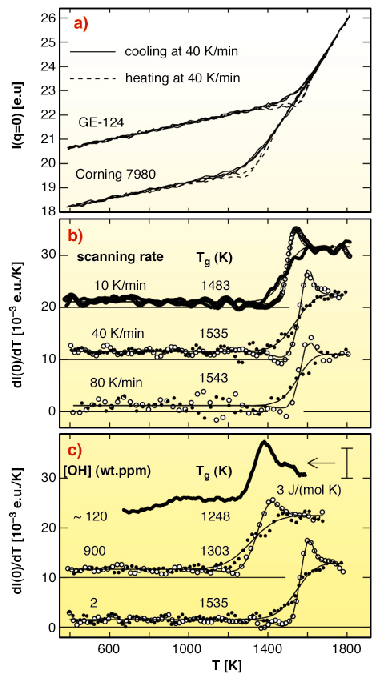- Home
- Users & Science
- Scientific Documentation
- ESRF Highlights
- ESRF Highlights 2005
- High Resolution and Resonance Scattering
- Characterisation of the Glass Transition in Vitreous Silica by Temperature-scanning SAXS
Characterisation of the Glass Transition in Vitreous Silica by Temperature-scanning SAXS
Vitreous silica is a key material for fiber optics communication, technology and science [1]. For pure SiO2 only incomplete information is available for the transition from the supercooled liquid to the frozen glass state. The hysteresis that glasses typically exhibit as they are cooled and heated through the glass transition had never been observed for SiO2, mainly due to the high temperatures involved.
Small angle X-ray scattering (SAXS) by liquids and glasses, extrapolated to the zero angle (q = 0), reveals static and dynamic density fluctuations. Density fluctuations in liquids depend only on temperature, whereas the glass state depends also on the history of the material. A high-temperature molybdenum furnace and a CCD camera were used in conjunction with the D2AM experimental setup to measure the SAXS as a function of temperature. The camera continuously recorded the X-rays scattered by 1.0 mm thick glass plates that were heated and cooled at fixed rates.
 |
|
Fig. 30: (a) X-ray scattering intensity, extrapolated to q = 0, as a function of temperature. GE 124 contains 2 wt. ppm H2O, and Corning 7980 contains 900 wt. ppm H2O. (b) Temperature derivatives of I(0), obtained for GE-124 upon scanning the temperature at different rates. Full and open symbols show cooling and heating data, respectively. (c) Temperature derivatives of I(0) data obtained at 40 K/min for GE-124 and Corning 7980, and heat flow upon heating a sample with 120 wt. ppm at 40 K/min. |
The scattered intensity, extrapolated to q ![]() 0 (the centre of the CCD image), is shown in Figure 30a for two commercial glasses. The curves show the strong influence of even small amounts of residual water on the glass transition temperature, Tg. The hysteresis of the density fluctuations can be seen clearly in the I(q = 0) curves and in their derivatives (Figures 30b and c). These differentiated signals match to the signature of the glass transition seen by calorimetry (Figure 30c). The slopes of the I(q = 0) curves above and below Tg agree with the slopes found by light scattering experiment to within 14% [2]. This is interesting as light probes the structure of the material at length scales that are larger by about a factor of 100. Standard kinetic parameters like the Kohlrausch stretching exponential have been obtained from the data by fitting. The fits are shown as solid lines in Figures 30b-c.
0 (the centre of the CCD image), is shown in Figure 30a for two commercial glasses. The curves show the strong influence of even small amounts of residual water on the glass transition temperature, Tg. The hysteresis of the density fluctuations can be seen clearly in the I(q = 0) curves and in their derivatives (Figures 30b and c). These differentiated signals match to the signature of the glass transition seen by calorimetry (Figure 30c). The slopes of the I(q = 0) curves above and below Tg agree with the slopes found by light scattering experiment to within 14% [2]. This is interesting as light probes the structure of the material at length scales that are larger by about a factor of 100. Standard kinetic parameters like the Kohlrausch stretching exponential have been obtained from the data by fitting. The fits are shown as solid lines in Figures 30b-c.
In conclusion, temperature-scanning SAXS resolved the glass transition in vitreous silica. A higher amount of residual water decreases Tg, and broadens the glass transition.
References
[1] M. Tomozawa, in Silicon-Based Materials and Devices H.S. Nalwa (Ed.), Academic Press, New York, 127 (2001).
[2] K. Saito, A.J. Ikushima, Appl. Phys. Lett., 70, 3504 (1997).
Principal Publication and Authors
R. Brüning (a), C. Levelut (b), A. Faivre (b), R. Le Parc (b), J.-P. Simon (c), F. Bley (c), J.-L. Hazemann (d), Europhys. Lett., 70, 211-217 (2005).
(a) Physics Dept., Mount Allison University (Canada)
(b) Laboratoire des Colloïdes, Verres et Nanomatériaux, Montpellier (France)
(c) LTPCM-CNRS-INPG-UJF, Grenoble (France)
(d) Laboratoire de Cristallographie, CNRS-Grenoble (France)



